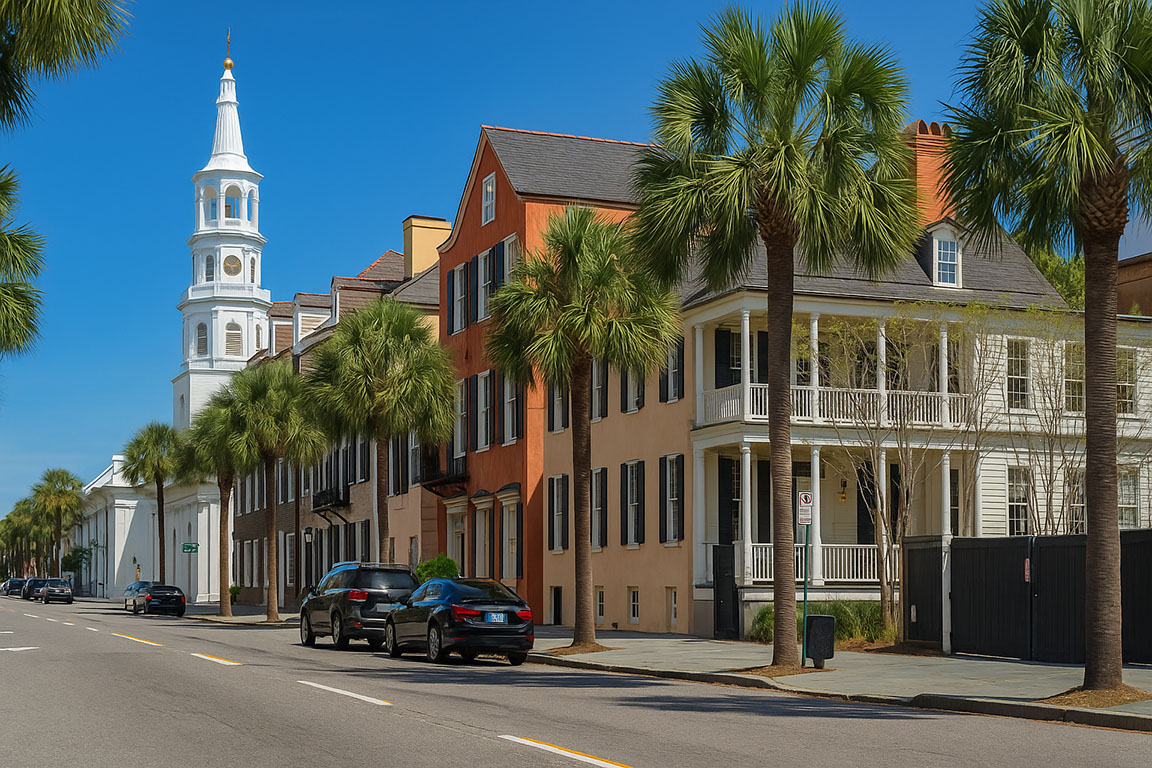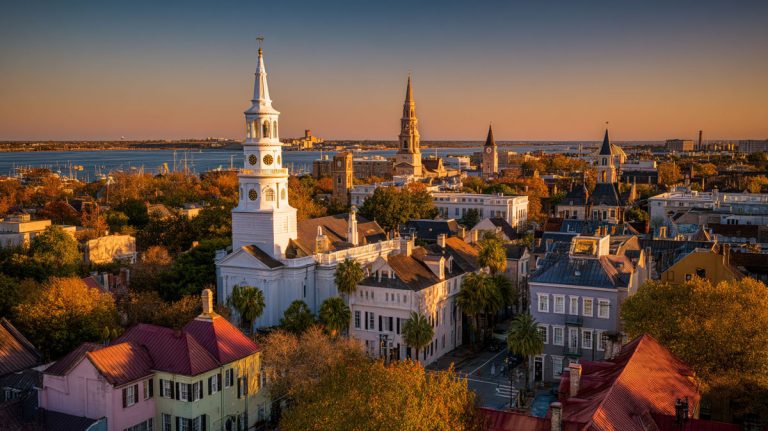Overview
Charleston, located on the southeastern coast of South Carolina, has drawn people in for centuries with its coastal charm. It sits on a peninsula surrounded by the Ashley, Cooper, and Wando Rivers, all converging where the city opens up into the Atlantic.
According to the U.S. Census Bureau, Charleston’s population has exceeded 150,000 in recent years, and projections through 2025 indicate steady growth. This rising figure reflects an ongoing surge in popularity among families, young professionals, and retirees who find themselves drawn to a place that stands at the crossroads of classic architecture and modern development.
The blend of history, culture, and coastal living is what makes the largest city in South Carolina such a compelling destination. If you are considering a move to Charleston, you’ve come to the ideal place to learn more about what it’s like living in one of the most popular places in South Carolina!
Charleston, SC Real Estate Market
The city’s housing market has been on an upswing for a decade, propelled by the local tourism industry, a growing tech scene, and continued demand from out-of-state buyers seeking coastal life.
While Charleston offers lower property taxes than some major metropolitan areas, it is generally considered pricier than many parts of the South. A study by Numbeo suggests that the city’s overall cost of living runs roughly 10% above the national average.
That can be felt especially in housing expenses, where homes for sale in Charleston, SC averaged near $500,000 in 2025, though prices can climb even higher in coveted historic districts like downtown Charleston or in waterfront neighborhoods on James Island.
Most Popular Places to Live in Charleston
Mount Pleasant
Mount Pleasant offers everything you need including scenic waterfront parks, marinas, and wide thoroughfares lined with shops and restaurants. It balances newer developments with traces of its early roots, offering some of the top schools in the region and a range of housing options—from traditional single-family homes to modern townhouses.
With quick access to downtown Charleston via the Ravenel Bridge and proximity to popular beaches, this suburban area is a great choice for those relocating to Charleston. Some even say it’s one of the best places to live in South Carolina.
South of Broad
South of Broad marks the southern tip of the Charleston peninsula, where cobblestone streets meet historic mansions that seem pulled from centuries past. Enormous porches, wrought-iron gates, and private gardens line quiet roads that overlook the Battery and Charleston Harbor.
Living here can mean a short walk to waterfront vistas and an up-close view of the city’s storied architectural heritage. It’s one of Charleston’s most prestigious neighborhoods, sought after by those who prize location and charm in equal measure.
The French Quarter
Charleston’s French Quarter captures the artistic spirit of the city within a compact grid of galleries, theaters, and performance spaces. Tucked between the grand thoroughfares of East Bay and Meeting Street, it has a reputation for drawing creative minds and hosting a lively cultural calendar, including events that showcase local and international talent.
The Pros of Living in Charleston, SC
Rich History and Culture
Charleston is often called a living museum. It’s home to centuries-old cobblestone streets, antebellum mansions, and a Civil War port that shaped the trajectory of the nation.
History is embedded in everyday life: you can pass by Rainbow Row with its pastel Georgian houses, then head over to the Battery for a panoramic view of the harbor, all while weaving through neighborhoods that once bore witness to pivotal chapters in American history.
Much of this storied past is preserved and shared at museums like The Charleston Museum—founded in 1773, it’s one of the oldest museums in the nation.
But history here isn’t confined to exhibits. Local festivals such as Spoleto Festival USA celebrate performing and visual arts. Live music can be heard drifting through open doors of downtown area bars. Jazz, which found its footing in nearby cities, is a persistent presence in Charleston’s music scene.
All these threads of heritage and art make it easy to explore Charleston by day and enjoy nights bursting with energy.
Thriving Culinary Scene
Food in Charleston is more than a necessity—it’s a conversation, a community affair, and a legacy passed down through generations.
Local dishes pull from the marshes and nearby waters: shrimp and grits is a staple; Lowcountry boil sees fresh shrimp, corn, sausage, and potatoes piled high on picnic tables; oysters emerge in droves during the cooler months, fueling neighborhood roasts where locals stand around open fires, opening steaming shells.
Dining in Charleston can swing from down-home comfort to high-end gastronomy. Spots like Husk, FIG, and Magnolia’s have garnered national recognition. It’s not all about Southern fare, though. In recent years, an array of international cuisines—Thai, Ethiopian, Vietnamese—has joined the roster, reflecting an increasingly diverse population.
Food trucks, farmers markets such as the Charleston city market, and fresh produce stands are a common weekend sight, making it easy to source locally grown goods for home cooking as well. There is certainly no shortage of things to do in Charleston!
Access to Beaches
Charleston’s coastal position means the beach is never far away. Whether you’re partial to the popularity of Folly Beach or the upscale vibe of Isle of Palms, there’s a sandy spot for every preference.
Folly Beach attracts surfers to its waves and artists to its sunrise views. Isle of Palms and Sullivan’s Island, on the other hand, lean toward a quieter pace, with residential streets, upscale dining, and scenic marsh views. Other coastal gems like Kiawah Island, Daniel Island, and John’s Island offer their own unique blends of natural beauty, recreational opportunities, and lowcountry charm.
Being so close to the water isn’t just about sunbathing. Locals cast lines off piers for redfish, gather nets for crabbing, and paddle kayaks through tidal creeks that wind behind the barrier islands. Water sports—jetskiing, kitesurfing, paddleboarding—are a regular weekend pastime.
Family-Friendly Environment
The city and its suburbs have become popular among families seeking that balance between modern amenities and a more relaxed coastal lifestyle.
Charleston is home to many well-regarded schools: the Charleston County School District offers a wide range of programs, and private institutions also have a strong presence.
Recreation opportunities abound for families with young children. Public parks, such as Hampton Park on the peninsula or the Mt. Pleasant Memorial Waterfront Park across the Cooper River, provide space for picnics, running around, or simply unwinding after a long day. Waterfront concerts and open-air markets create opportunities for kids to interact with neighbors in a friendly atmosphere.
Booming Job Market
Charleston’s job market has been on an upward trend for years. Once dominated by tourism and hospitality, its economy has since diversified.
Major employers include the Medical University of South Carolina (MUSC) and Roper St. Francis Healthcare—two giants in the healthcare sector. Boeing Company has a sprawling facility north of the city has brought in thousands of jobs, injecting the region with a steady demand for engineers, technicians, and support staff. Volvo’s assembly plant in nearby Berkeley County further contributes to the city’s growing manufacturing sector. Meanwhile, a burgeoning tech scene known as “Silicon Harbor” has gained traction, with software companies popping up downtown and in neighboring communities.
All this job growth has encouraged new housing developments, improved infrastructure, and an influx of newcomers seeking stable career opportunities. The Port of Charleston, one of the busiest on the East Coast, continues to support logistics and supply chain jobs, making trade a key economic driver. With the convenience of Charleston International Airport nearby and a thriving economy that offers something for everyone, the city continues to attract talent from across the country.
The Potential Cons of Living in Charleston, SC
High Cost of Living in Charleston
While Charleston’s economy has blossomed, so have certain expenses. Housing in particular stands out. Prices of single-family homes in popular areas like Mount Pleasant can easily exceed the citywide average of $500,000, as reported by Zillow.
Downtown condos can run even higher, particularly if they include water views or a spot in a historic building. Renters don’t escape the pinch either. A two-bedroom in desirable neighborhoods can surpass $2,000 per month, not including utilities.
Lack of Public Transportation to Get Around Charleston
Charleston’s public transportation network is limited compared to larger metropolitan areas. CARTA (Charleston Area Regional Transportation Authority) operates a bus system that covers some key routes, but not every neighborhood is serviced frequently or conveniently. Visitors sometimes opt for the free DASH trolleys downtown, but those only loop through the tourist districts.
Most locals rely on cars for daily errands and commuting. Traffic congestion along the Interstate 26 corridor, particularly during rush hour, can be frustrating. Travel times can double during peak tourist season, when the region’s population swells with visitors.
Ride-share services like Uber and Lyft do help, but heavier reliance on personal vehicles means factoring in parking fees, gas, and insurance costs. For newcomers, it’s important to consider location carefully—choosing a neighborhood close to work or school can be a significant stress reliever.
Tourism
Charleston consistently ranks as a top U.S. travel destination, with accolades from major travel publications. This surge in visitors energizes the local economy—bringing in billions of dollars annually—but also adds to the hustle and bustle of daily life. Streets in the historic district fill up with tour buses, carriage rides, and groups of sightseers snapping photos. Lines can form outside popular restaurants. Parking downtown can feel like a scavenger hunt.
During peak travel seasons in spring and fall, weekend traffic can be on par with that of larger cities. Beaches fill up quickly, especially on hot summer days.
If you’re prepared for a busier vibe and the perks that come with a steady influx of out-of-towners, Charleston still stands as a rewarding place to call home.
So, is Charleston, SC one of the best places to live?
Making the move to Charleston can be a major life decision—some say it’s one of those defining choices that reshapes how you work, play, and see the world. It’s a place where time feels connected to the tides, and where modern industries exist alongside centuries-old architecture—all wrapped in a culture known for its southern hospitality.
Before you pack up and head south, do some deep digging. Think about housing costs, commute times, school options, and your tolerance for summer humidity. There’s no denying that the city’s got a magnetic draw, brimming with historical significance, culinary milestones, and scenic coastlines.
If you’re ready for a coastal environment with a robust dining culture and a growing job market, it might just be the best place you’ve ever called home.
FAQs About Living in Charleston, South Carolina
What is the best way to get around Charleston?
Charleston remains a car-centric city, largely due to limited public transportation options. Many year-round residents rely on personal vehicles for daily errands and commuting. The bus system, operated by CARTA, provides coverage in key areas, but routes can be infrequent, especially in less populated neighborhoods. Downtown’s free DASH trolleys are helpful for short trips within the historic district, and ride-share services like Uber and Lyft fill in some gaps. For those staying or living near the peninsula, walking can be pleasant, especially outside peak summer heat, and there’s an emerging network of bike lanes for shorter distances.
Is Charleston safe to live in?
Crime rates vary by neighborhood, as in any city. Popular areas like downtown, Mount Pleasant, and West Ashley tend to have lower crime rates, while some districts in North Charleston report higher incidents. Consulting local crime maps and speaking to residents can help you choose a comfortable location for your needs.
What’s the weather like in Charleston, SC?
Charleston has a subtropical climate with over 230 days of sunshine with its hot, humid summer months and mild winters. Hurricanes and tropical storm are possible from June through November, so coastal storms remain a seasonal concern.
How expensive is housing in Charleston?
Affordable housing can be tough to find in Charleston as housing costs can be higher than many other Southern cities. In 2025, the average home price hovered around $500,000, while rents for a two-bedroom apartment often exceeded $2,000 per month in popular areas. Suburbs and outlying towns generally offer more affordable options, though commute times can increase.





